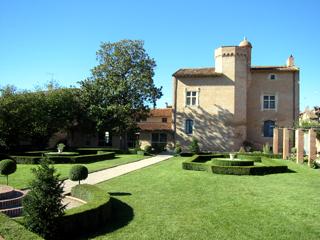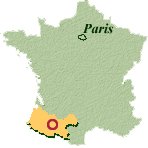Musée Ardouin

The Hotel d'Ardouin was built in 1580 by Pierre de Garrigues, a wealthy woad merchant who came to live in Mazères after his marriage to Françoise d'Agreville. His wife, Françoise d'Agreville, came from a Protestant family that was the most important family in the town since it had, the leadership of the Syndic du Comté de Foix (1549).
The couple had two girls, Marthe and Madeleine. Pierre de Garrigues died at a young age in 1590, but the nickname of "Grand Vicomte" which was given to him (and quoted in the town records) is undoubtedly homage to his beautiful work.
In 1598, Marthe married Jean Antoine Ardouin (who was also a protestant and who, in 1614, became the treasurer of the "Council Municipal").
The estate of Monsieur de Garrigues was distributed one year later and Marthe inherited the family home, with its garden and other buildings.
Curiously, the hotel will no longer carry the name of its builder, Pierre de Garrigues; rather it takes on the name of its inheritor, the son-in-law, Jean Antoine d'Ardouin.
Listed as an official historical monument, the Hotel d'Ardouin has recently profited from a complete restoration. The Hotel is built with brick and all of the openings are framed with white stone, with in particular, on the second floor, very beautiful, finely worked mullioned windows. One octogonal tower dominates the building, prolonged by a corbelled turret. This turret is reached by a beautiful spiral staircase of stone, which terminates under a brick dome. From the terrace, one enjoys a unique view of the roofs of the village, the Lauragais and the Pyrenees.
The garden, designed in the spirit of the 16th and 17th centuries, is planted uniquely with species existing at that time.
The Museum of Mazères is partly devoted to the WOAD and the long alchemy, which, from the fields of the Lauragais to the vat of the dyer, transforms an ordinary plant into a blue that has become legendary.
In the beautiful arched cellars, a room is reserved for the history of Mazères, with objects from prehistoric times to the vestiges of the prestigious Abbey of Boulbonne to which we owe creation, in 1253, of the existing fortified town.
Another room testifies to the everyday life in the rural community during the first half of the twentieth century.
On the first floor, an evocation of Gaston Fébus, recalls the extraordinary life of this important medieval lord. There is also a model of the castle that her had built in Mazères, his favorite town in the "Comté de Foix".
Yet another room offers a rich and documented World War II exposition (just only open during the summer).
Lastly, a very beautiful brick Languedocian chimney from the 16th century, occupies an entire wall of the last room, which is devoted to temporary expositions.
|
Add this place to your selection

|











